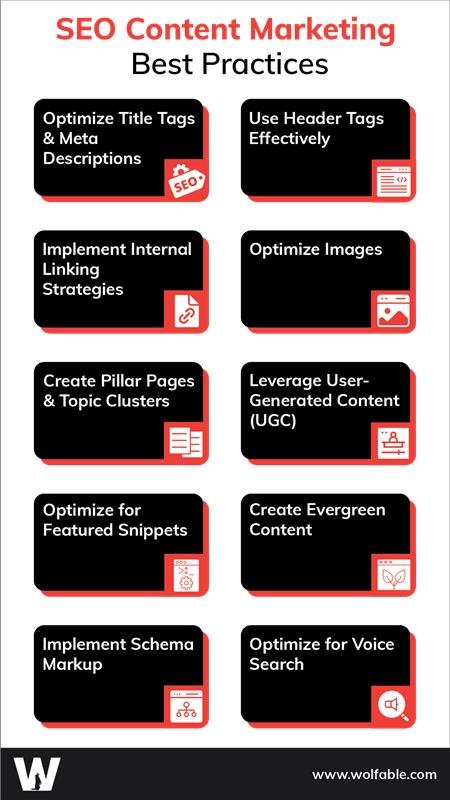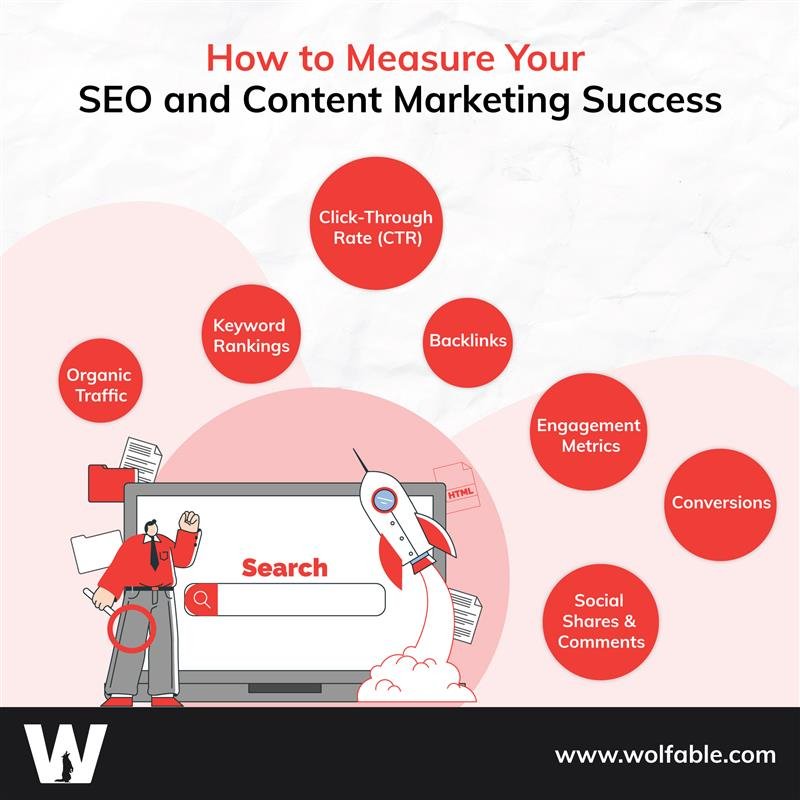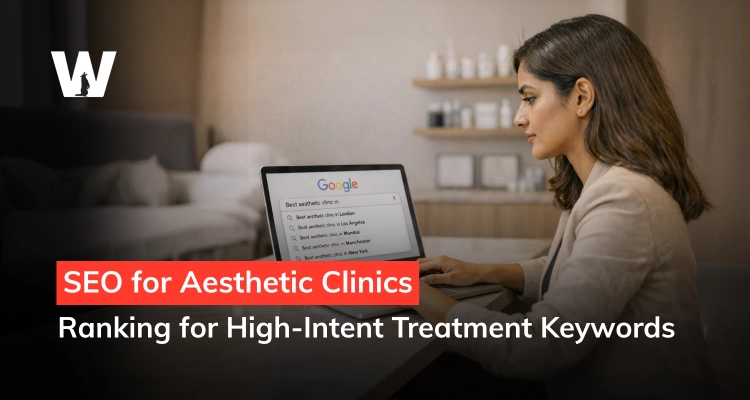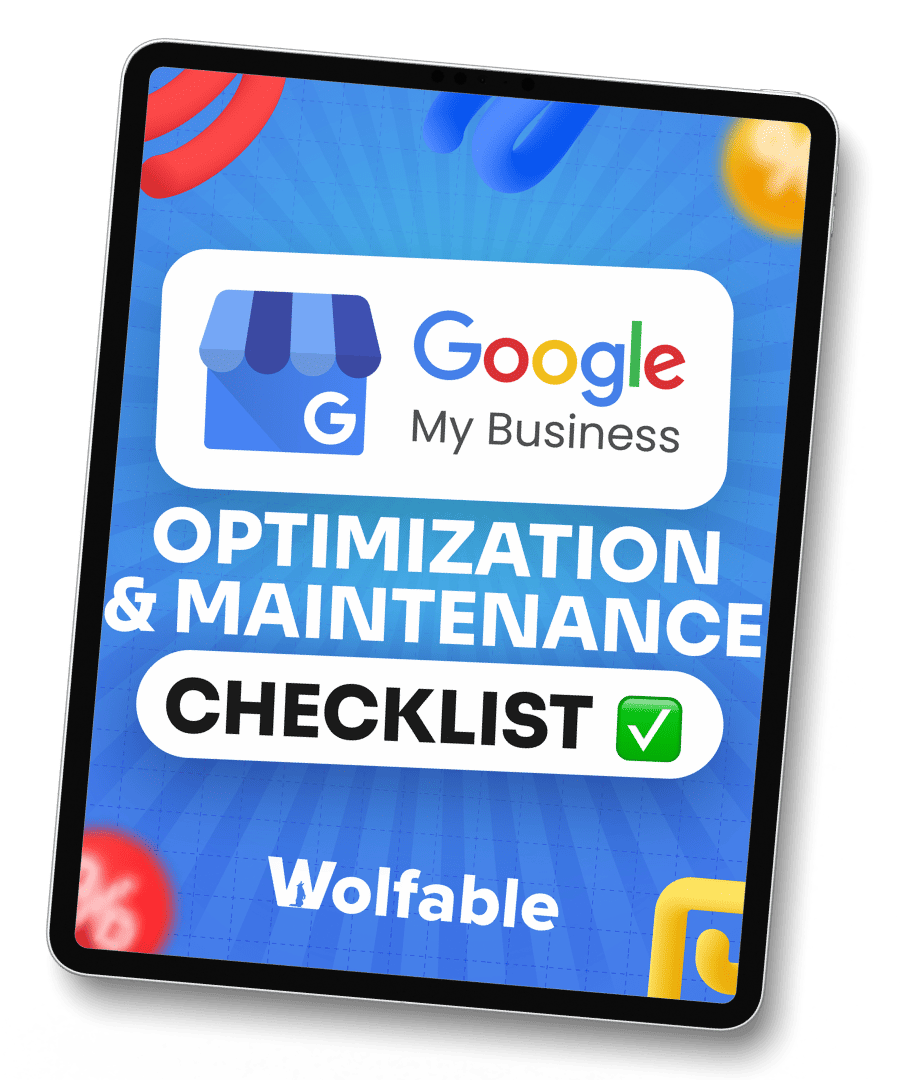Wraps up in 12 Minutes
Nowadays, getting your content seen online is more important than ever.
Whether you're running a small business, managing a blog, or working for a large corporation, you want your message to reach as many people as possible.
That's where content marketing and SEO come into play.
You might have heard these terms before, but do you really know what they mean and how they work together? Don't worry if you're not sure – you're in the right place.
In this post, we will discuss everything about content marketing and SEO, and how these two powerful strategies can work in harmony to boost your online visibility.
What is SEO?
In simple terms, SEO is all about making your website and its content more attractive to search engines like Google.
The goal? To have your pages show up higher in search results when people look for topics related to your business or content.
SEO isn't just one thing – it's a combination of strategies and techniques.
Here are the key components:
- On-page SEO: This involves optimizing the content on your website. It includes things like using the right keywords, creating quality content, and making sure your page titles and descriptions are on point.
- Off-page SEO: This refers to actions taken outside of your website to improve its search engine rankings. The most common example is building backlinks – getting other reputable websites to link to yours.
- Technical SEO: This is the behind-the-scenes stuff. It includes making sure your website loads quickly, is mobile-friendly and has a structure that search engines can easily understand and navigate.
Search engines use complex algorithms to decide which pages should rank highest for any given search query.
These algorithms consider hundreds of factors, from the relevance of your content to the user experience your site provides.
It's worth noting that SEO isn't a static field. Search engines are constantly updating their algorithms, which means SEO practices need to evolve too. What worked five years ago might not be as effective today. That's why staying up-to-date with SEO trends is crucial for long-term success.
What is Content Marketing?
Now that we've covered SEO, let's talk about content marketing.
For the uninitiated, content marketing is all about creating and sharing valuable, relevant content to attract and engage a specific audience.
Unlike traditional advertising, which often interrupts people with sales messages, content marketing aims to provide information or entertainment that your audience actually wants or needs.
When we say "content," we're talking about a wide range of formats.
Here are some common types:
- Blog posts (like the one you're reading right now!)
- Videos
- Infographics
- Podcasts
- Social media posts
- Ebooks
- Whitepapers
- Case studies
The goal of content marketing isn't just to get people to visit your website once. It's about building a relationship with your audience. When you consistently provide valuable content, you can establish trust, demonstrate your expertise, and keep people coming back for more.
Think of content marketing as a funnel. At the top, you have content that attracts a wide audience and raises awareness about your brand. As you move down the funnel, your content becomes more specific, addressing the needs and questions of people who are closer to making a purchase or taking a desired action.
Remember, good content marketing isn't about constantly promoting your products or services. It's about providing value to your audience.
When you do this consistently, you'll find that your audience is more likely to trust your brand and consider your offerings when they're ready to buy.
SEO vs Content Marketing: How Are They Different?
While content marketing and SEO are closely related, they do have some key differences.
Let's break them down:
Primary Focus
SEO: focuses on optimizing your content and website to rank higher in search engine results.
Content Marketing: focuses on creating valuable, relevant content to engage and attract your target audience.
Timeframe
SEO: It often requires a longer time to see significant results. It can take months for your SEO efforts to pay off in terms of improved rankings.
Content Marketing: It can sometimes yield quicker results, especially on platforms like social media where content can go viral quickly.
Metrics
SEO: The success of SEO is often measured by metrics like organic traffic, keyword rankings, and backlinks.
Content Marketing: It typically looks at engagement metrics like shares, comments, time on page, and conversions.
Audience
SEO: It primarily targets search engines (although ultimately, it's about reaching human searchers).
Content marketing: Content marketing directly targets human readers, viewers, or listeners.
Techniques
SEO: It involves technical optimization like improving site speed, using the right HTML tags, and building a solid site structure.
Content marketing: It focuses more on storytelling, providing value, and creating content that resonates with your audience.
When you're thinking about content marketing vs SEO, it's important to remember that while they have different focuses, they work best when used together.
In fact, you'll often find that good content marketing naturally incorporates SEO best practices, and effective SEO relies heavily on quality content.
How Content Marketing Helps SEO?
Let's look at how content marketing can give your SEO efforts a significant boost:
Creates More Indexable Pages
Every piece of content you create is a new page for search engines to index. The more quality pages you have, the more opportunities you have to rank for different keywords.
For example, if you run a gardening website and create a series of blog posts about different types of roses, each of those posts is a new opportunity to rank for specific rose-related searches.
Generates Natural Backlinks
When you create valuable, shareable content, other websites are more likely to link to it. These backlinks are gold for SEO, as they signal to search engines that your content is trustworthy and authoritative.
For instance, if you create an in-depth guide on sustainable gardening practices, other gardening blogs or environmental websites might link to your guide as a resource for their readers.
Improves User Engagement Metrics
Good content keeps people on your site longer, reduces bounce rates, and encourages visitors to explore more pages. These are all positive signals to search engines that your site provides value to users.
If someone lands on your blog post about pruning roses and finds it helpful, they might stick around to read your posts about soil types or pest control, improving your overall engagement metrics.
Builds Brand Authority and Trust
Consistently publishing high-quality content establishes your brand as an authority in your field. This can lead to more branded searches, which is great for SEO.
As you become known as a go-to resource in your industry, more people will search for your brand name directly, which can improve your overall search visibility.
Targets Long-Tail Keywords
Content marketing allows you to target a wide range of long-tail keywords naturally. These specific phrases often have less competition and can drive highly targeted traffic to your site.
For example, while it might be hard to rank for "gardening tips," you could create content that ranks well for "how to grow roses in clay soil."
Keeps Content Fresh and Updated
Search engines love fresh content. A regular content marketing strategy ensures your site is continually updated, which can improve your search rankings. This doesn't always mean creating new content – updating and refreshing your existing content can also signal to search engines that your site is current and relevant.
In short, when you focus on creating valuable content for your audience, you're helping your content marketing efforts and laying a strong foundation for SEO success. It's a win-win situation!
Encourages Social Sharing
While social shares aren't a direct ranking factor, they can indirectly benefit your SEO.
When your content gets shared on social media, it increases its visibility, which can lead to more backlinks and traffic – both of which do impact your search rankings.
Allows for Content Diversification
Content marketing encourages you to create various types of content, which can help you appear in different types of search results.
For example, creating video content could help you appear in video search results while creating infographics could help you appear in image search results.
Provides Opportunities for Internal Linking
As you create more content, you have more opportunities to link between your own pages. This internal linking structure helps search engines understand the relationship between your content and can distribute link equity throughout your site.
Improves E-E-A-T (Experience, Expertise, Authoritativeness and Trustworthiness)
Google places a high value on E-E-A-T when determining search rankings, especially for YMYL (Your Money or Your Life) topics.
A solid content marketing strategy that demonstrates your expertise and provides valuable information to your audience can improve your E-E-A-T in the eyes of search engines.
How to Use SEO and Content Marketing Together?
Now that we understand how SEO and content marketing complement each other, let's dive into how you can use them together effectively.
We'll break this down into three key steps:
1. Understand Your Target Audience
Before you start creating content or optimizing for search engines, you need to know who you're trying to reach. Here's how:
- Create buyer personas: These are fictional representations of your ideal customers. Consider factors like age, occupation, interests, challenges, and goals. For example, if you're running a fitness blog, one of your personas might be "Busy Mom Melissa," a 35-year-old working mother who wants to get back in shape but struggles to find time for exercise.
- Analyze search intent: What are people looking for when they search for terms related to your business? Are they looking to buy, learn, or find a specific piece of information? For "Busy Mom Melissa," search intent might include phrases like "quick workouts for busy moms" or "healthy meals for families on the go."
- Map content to the buyer's journey: Create content that addresses needs at every stage, from awareness to consideration to decision. For our fitness blog, awareness content might be general health tips, consideration content could be comparisons of different workout programs, and decision content might be success stories or free trial offers.
- Conduct surveys and interviews: Get direct feedback from your audience about what they want to see from your content. This can provide invaluable insights that you might not get from data alone.
Understanding your audience helps you create content that resonates with them and choose the right keywords to target. It's the foundation of both your content marketing and SEO strategies.
2. Find the Right Keywords
Keywords are the bridge between SEO content strategy and what your audience is searching for.
Here's how to find the right ones:
- Use keyword research tools: Tools like Google Keyword Planner, SEMrush, or Ahrefs can help you discover relevant keywords and their search volumes. Look for keywords that have a good balance of search volume and competition.
- Consider long-tail keywords: These are longer, more specific phrases. They often have less competition and can drive highly targeted traffic. For our fitness blog, instead of just targeting "workout tips," we might target "10-minute workout tips for busy moms."
- Look at keyword difficulty: This metric tells you how hard it would be to rank for a particular keyword. Balance search volume with difficulty to find the best opportunities. A keyword with high search volume but low difficulty is ideal.
- Analyze competitor keywords: See what keywords your competitors are ranking for. This can reveal opportunities you might have missed and help you understand what's working in your industry.
- Integrate keywords naturally: Once you've chosen your keywords, incorporate them into your content in a way that feels natural and adds value for the reader. Avoid keyword stuffing – search engines are smart enough to understand context and synonyms.
Remember, keyword research isn't a one-time task. You should regularly revisit your keyword strategy to stay on top of changing search trends and find new opportunities.
3. Create High-Quality, Helpful & Informative Content
This is where content marketing and search engine optimization truly come together.
Here's how to create content that satisfies both your audience and search engines:
- Focus on user intent: First of all, you need to make sure that your content answers the questions or solves the problems that lead people to search for your target keywords. For example, if you're targeting "quick workouts for busy moms," your content should provide actual workout routines that can be done in a short amount of time, not just general fitness advice.
- Develop comprehensive, in-depth content: Generally, longer, more detailed content tends to rank better in search results. Aim to cover topics thoroughly. This doesn't mean adding fluff – every word should provide value. A comprehensive guide on "quick workouts for busy moms" might include not just workout routines, but also tips on finding time to exercise, staying motivated, and incorporating kids into workout routines.
- Use multimedia elements: Include images, videos, or infographics to make your content more engaging and valuable. This not only improves user experience but also gives you opportunities to optimize for image and video searches. For our fitness blog, we might include demonstration videos for exercises or infographics showing the benefits of regular physical activity.
- Ensure readability and scannability: When writing content, use short paragraphs, subheadings, and bullet points to make your content easy to read and understand. This is especially important for mobile users. Break down your workout guide into clear sections like "Warm-up," "Main Routine," and "Cool Down" to make it easy to follow.
- Implement proper on-page SEO techniques: This includes optimizing your title tags, meta descriptions, header tags, and image alt text. Make sure your target keyword appears in these elements naturally. For our workout guide, we might use a title tag like "10-Minute Workouts for Busy Moms: Quick, Effective Exercises."
- Create a content calendar: You also need to plan your content in advance to ensure a consistent publishing schedule and a good mix of topics. This helps both with SEO (as search engines favor regularly updated sites) and with content marketing (as it helps build a loyal audience).
- Optimize for featured snippets: It’s important to structure some of your content in a way that makes it likely to be picked up as a featured snippet in search results. This might mean using a question as a header and providing a concise answer immediately after, or using a structured list format.
- Include internal and external links: Next, you should link to other relevant content on your site to keep users engaged and help search engines understand your site structure. Also, link to reputable external sources to provide additional value to your readers and show search engines that your content is well-researched.
- Keep it fresh: You need to regularly update your content to ensure it remains accurate and relevant. Search engines favor fresh content, and your audience will appreciate up-to-date information.
- Encourage engagement: You should also Include call-to-actions that encourages comments, shares, or other forms of engagement. This can improve your content's performance both in terms of SEO and content marketing goals.
Remember, the key is to always prioritize your audience's needs. When you create content that truly helps your readers, you're more likely to see success in both areas.
SEO Content Marketing Best Practices
Now that you understand the basics of combining SEO and content marketing, let's check out some best practices that will help you maximize your efforts:

1. Optimize Title Tags & Meta Descriptions
Title tags and meta descriptions are your first opportunity to make an impression in search results. Therefore, they need to be compelling enough to make someone want to click through to your content.
When crafting these elements, it’s important to include your target keywords naturally while also creating an engaging snippet that accurately represents your content.
For example, if you're writing a guide about quick workouts for busy moms, your title tag might be "10-Minute Workouts for Busy Moms: Quick, Effective Exercises."
This title includes the key phrase "workouts for busy moms" and gives a clear indication of what the reader can expect – quick, 10-minute routines.
The meta description could expand on this: "Discover easy, time-efficient workouts designed for busy moms. Get fit in just 10 minutes a day with our expert-approved exercise routines. No equipment needed!"
Remember to keep your title tags under 60 characters and meta descriptions under 160 characters to ensure they display fully in search results.
2. Use Header Tags Effectively
Header tags are popular because they provide structure and help both readers and search engines understand the hierarchy of information on your page.
Your H1 tag should be used for the main title of your page and should include your primary keyword. There should only be one H1 tag per page.
H2 tags are used for main sections of your content, while H3 tags can be used for subsections within those main sections. For our workout guide, we might use H2 tags for main sections like "Warm-up Exercises," "Core Workout," and "Cool Down Stretches." Under the "Core Workout" H2, we might have H3 tags for specific exercises like "Plank Variations" and "Bodyweight Squats."
Using header tags effectively not only improves the readability of your content but also gives you more opportunities to include relevant keywords in prominent positions.
3. Implement Internal Linking Strategies
Internal linking helps both users and search engines navigate your site and understand the relationships between different pieces of content.
When you link to other relevant pages on your site, you keep visitors engaged for longer and distribute page authority throughout your site.
For instance, in our workout guide for busy moms, we might link to related articles about nutrition for busy moms or the benefits of short, intense workouts. These links provide additional value to readers who want to learn more about related topics.
Furthermore, they also help search engines understand the context of your content and the overall structure of your site.
4. Optimize Images
Images can significantly enhance your content, making it more engaging and easier to understand. However, they can also slow down your page if not optimized properly.
So, it is recommended to use descriptive file names for your images – instead of "IMG_1234.jpg," use something like "squat-demonstration.jpg." This helps search engines understand what the image is about.
For this, you can compress your images to ensure fast loading times without sacrificing quality. There are many tools available for this, both online and as software you can install. Apart from this, you should also include relevant alt text for your images.
Alt text serves two important purposes — 1) it provides a text alternative for screen readers, making your content more accessible, and 2) it gives search engines more information about your image content.
5. Create Pillar Pages & Topic Clusters
Pillar pages and topic clusters are a content strategy that can significantly boost your SEO efforts.
A pillar page is a comprehensive guide on a broad topic, while topic clusters are more in-depth pieces of content that link back to the pillar page. This structure helps establish your site as an authority on a particular subject and creates a clear hierarchy of information for both users and search engines.
For a fitness blog, a pillar page might be "Complete Guide to Home Workouts," covering the basics of working out at home. Topic clusters could then dive deeper into specific aspects, with pages like "Equipment-Free Exercises," "Creating a Home Gym," and "Nutrition for Home Workouts."
Each of these cluster pages would link back to the main pillar page, and the pillar page would link out to each cluster page.
This strategy not only helps with SEO by creating a clear structure of related content, but it also provides a great user experience.
6. Leverage User-Generated Content (UGC)
User-generated content (UGC) can be a powerful tool in your SEO and content marketing arsenal. It provides fresh, unique content and shows search engines that your site is active and engaging.
UGC can take many forms, including reviews, comments, forum posts, and social media content that you share on your site.
For a fitness blog, you might have a section where users can share their own quick workout ideas or success stories. This not only provides valuable content for other readers but also helps build a community around your brand.
From an SEO perspective, UGC can help your site rank for long-tail keywords that you might not have thought to target yourself. It also keeps your site fresh and updated, which is something search engines value.
7. Optimize for Featured Snippets
Featured snippets are the boxes that appear at the top of some search results, providing a quick answer to a user's query.
Optimizing for featured snippets can significantly increase your visibility in search results. To do this, structure some of your content in a way that directly answers common questions in your niche.
For the fitness content, we might include a question like "What's a quick workout routine for busy moms?" followed by a concise, step-by-step answer.
This could be formatted as a numbered or bulleted list, which often works well for featured snippets. Tables and definitions are also commonly featured in snippets, so consider how you can incorporate these formats into your content where appropriate.
Remember, while optimizing for featured snippets, you should still focus on providing comprehensive, valuable content. The snippet should be a teaser that encourages users to click through to your site for more detailed information.
8. Create Evergreen Content
Evergreen content is content that remains relevant and valuable over a long period. While timely content has its place, focusing on evergreen topics can provide long-term SEO benefits.
This type of content continues to attract traffic and links long after it's published, providing ongoing value to both your audience and your SEO efforts.
For the fitness blog, a guide on "Basic Principles of Fitness" would be more evergreen than "Top Fitness Trends of 2023." Other examples of evergreen content could include "Proper Form for Common Exercises" or "Understanding Macronutrients."
These topics are always relevant to people interested in fitness, regardless of current trends or the time of year.
While evergreen content doesn't need to be updated as frequently as timely content, it's still a good idea to review it periodically to ensure all information is still accurate and to add any new insights or research.
9. Implement Schema Markup
Schema markup, also known as structured data, is a code that you can add to your website to help search engines understand your content better.
This can lead to rich snippets in search results, which can significantly increase your click-through rates.
There are many types of schema markup available, covering everything from articles and products to local businesses and events. Choose the types that are most relevant to your content. For a workout video, you might use the VideoObject schema to provide information about the video's duration, upload date, and thumbnail image.
While schema markup isn't a direct ranking factor, the rich snippets it enables can improve your visibility in search results and provide more informative results for users.
10. Optimize for Voice Search
With the rise of voice-activated devices, optimizing for voice search is becoming increasingly important. Voice searches tend to be more conversational and often take the form of questions.
If you want to optimize for voice search, focus on long-tail, conversational keywords, and provide direct, concise answers to common questions.
Voice search optimization also ties into local SEO, as many voice searches are for local information. If you have a physical location, make sure your local SEO is on point, with accurate and consistent information across all platforms.
Remember, optimizing for voice search often aligns well with creating helpful, user-focused content, so it's a win-win strategy.
How to Measure Your SEO and Content Marketing Success
Now, let’s assume that you’ve put in the work to create great content and optimize it for search engines. But how do you know if your efforts are paying off?
Here's how to measure the success of your combined SEO and content marketing strategy:

1. Organic Traffic
This is the number of visitors coming to your site from search engine results. An increase in organic traffic over time is a good indicator that your SEO efforts are working.
2. Keyword Rankings
The next metric to track for measuring your SEO and content marketing success is finding out where do your pages show up in search results for your target keywords. Tools like SEMrush or Ahrefs can help you track this. Remember, climbing from page 5 to page 2 is progress, even if you're not yet on the first page.
3. Click-Through Rate (CTR)
This shows how compelling your titles and meta descriptions are. A low CTR might indicate that your content is ranking well but not attracting clicks.
4. Backlinks
The number of backlinks pointing to your website is another important metric to track. However, quality is as important as quantity here – a link from a reputable fitness website would be more valuable than multiple links from unrelated or low-quality sites.
5. Engagement Metrics
Look at things like time on page, bounce rate, and pages per session. These indicate whether visitors find your content valuable.
6. Conversions
This helps you track if visitors are taking actions you want them to, like signing up for the newsletter or making a purchase.
7. Social Shares & Comments
While not direct SEO factors, these indicate that your content is resonating with your audience. High engagement can lead to more visibility and potential backlinks.
Conclusion
Combining content marketing and SEO is not just a good idea – it's essential for maximizing your organic content visibility in today's digital landscape.
Remember, this isn't a one-time effort. Both SEO and content marketing require ongoing work and adaptation. Search engine algorithms change, audience preferences evolve, and new competitors emerge.
If you can’t keep up with these evolutions, it’s best to partner with a digital marketing agency like Wolfable.
At Wolfable Digital Marketing Agency, we specialize in creating content that not only engages your audience but also ranks well in search engines. Our team of experts can help you develop a strategy that combines the best of content marketing and SEO to maximize your online visibility.
Contact Wolfable today, and let's work together to get your website the attention it deserves!
FAQs
While any type of high-quality content can perform well in SEO, some formats tend to do particularly well:
- In-depth, long-form articles (1500+ words)
- How-to guides and tutorials
- List posts (like "10 Ways to Improve Your SEO")
- Original research and data
- Visual content like infographics (when properly optimized)
Remember, the key is to create content that thoroughly answers your audience's questions and provides real value.
Voice search and AI are changing the way people interact with search engines.
Here’s how:
- Focus on natural language and conversational keywords
- Optimize for featured snippets, which are often used for voice search results
- Create content that directly answers specific questions
- Ensure your website is mobile-friendly
As AI becomes more prevalent in search, creating high-quality, original content becomes even more important.









